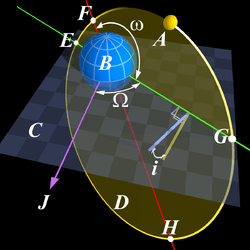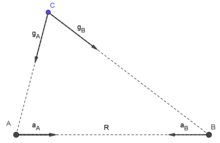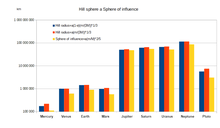Sphere of influence (astrodynamics)
A sphere of influence (SOI) in astrodynamics and astronomy is the oblate-spheroid-shaped region around a celestial body where the primary gravitational influence on an orbiting object is that body. This is usually used to describe the areas in the Solar System where planets dominate the orbits of surrounding objects such as moons, despite the presence of the much more massive but distant Sun. In the patched conic approximation, used in estimating the trajectories of bodies moving between the neighbourhoods of different masses using a two body approximation, ellipses and hyperbolae, the SOI is taken as the boundary where the trajectory switches which mass field it is influenced by.
| Part of a series on |
| Astrodynamics |
|---|
 |
|
Orbital parameters |
|
Gravitational influences |
|
Preflight engineering |
|
Efficiency measures |
The general equation describing the radius of the sphere of a planet:
where
- is the semimajor axis of the smaller object's (usually a planet's) orbit around the larger body (usually the Sun).
- and are the masses of the smaller and the larger object (usually a planet and the Sun), respectively.
In the patched conic approximation, once an object leaves the planet's SOI, the primary/only gravitational influence is the Sun (until the object enters another body's SOI). Because the definition of rSOI relies on the presence of the Sun and a planet, the term is only applicable in a three-body or greater system and requires the mass of the primary body to be much greater than the mass of the secondary body. This changes the three-body problem into a restricted two-body problem.
Table of selected SOI radii

The table shows the values of the sphere of gravity of the bodies of the solar system in relation to the Sun (with the exception of the Moon which is reported relative to Earth):[1]
| Body | SOI radius (106 km) | SOI radius (body radii) |
|---|---|---|
| Mercury | 0.112 | 46 |
| Venus | 0.616 | 102 |
| Earth | 0.929 | 145 |
| Moon | 0.0661 | 38 |
| Mars | 0.578 | 170 |
| Jupiter | 48.2 | 687 |
| Saturn | 54.5 | 1025 |
| Uranus | 51.9 | 2040 |
| Neptune | 86.8 | 3525 |
Increased accuracy on the SOI
The Sphere of influence is, in fact, not quite a sphere. The distance to the SOI depends on the angular distance from the massive body. A more accurate formula is given by
Averaging over all possible directions we get
Derivation
Consider two point masses and at locations and , with mass and respectively. The distance separates the two objects. Given a massless third point at location , one can ask whether to use a frame centered on or on to analyse the dynamics of .

Consider a frame centered on . The gravity of is denoted as and will be treated as a perturbation to the dynamics of due to the gravity of body . Due their gravitational interactions, point is attracted to point with acceleration , this frame is therefore non-inertial. To quantify the effects of the perturbations in this frame, one should consider the ratio of the perturbations to the main body gravity i.e. . The perturbation is also known as the tidal forces due to body . It is possible to construct the perturbation ratio for the frame centered on by interchanging .
| Frame A | Frame B | |
|---|---|---|
| Main acceleration | ||
| Frame acceleration | ||
| Secondary acceleration | ||
| Perturbation, tidal forces | ||
| Perturbation ratio |
As gets close to , and , and vice versa. The frame to choose is the one that has the smallest perturbation ratio. The surface for which separates the two regions of influence. In general this region is rather complicated but in the case that one mass dominates the other, say , it is possible to approximate the separating surface. In such a case this surface must be close to the mass , denote as the distance from to the separating surface.
| Frame A | Frame B | |
|---|---|---|
| Main acceleration | ||
| Frame acceleration | ||
| Secondary acceleration | ||
| Perturbation, tidal forces | ||
| Perturbation ratio |

The distance to the sphere of influence must thus satisfy and so is the radius of the sphere of influence of body
References
- Seefelder, Wolfgang (2002). Lunar Transfer Orbits Utilizing Solar Perturbations and Ballistic Capture. Munich: Herbert Utz Verlag. p. 76. ISBN 3-8316-0155-0. Retrieved July 3, 2018.
General references
- Bate, Roger R.; Donald D. Mueller; Jerry E. White (1971). Fundamentals of Astrodynamics. New York: Dover Publications. pp. 333–334. ISBN 0-486-60061-0.
- Sellers, Jerry J.; Astore, William J.; Giffen, Robert B.; Larson, Wiley J. (2004). Kirkpatrick, Douglas H. (ed.). Understanding Space: An Introduction to Astronautics (2nd ed.). McGraw Hill. pp. 228, 738. ISBN 0-07-294364-5.
- Danby, J. M. A. (2003). Fundamentals of celestial mechanics (2. ed., rev. and enlarged, 5. print. ed.). Richmond, Va., U.S.A.: Willmann-Bell. pp. 352–353. ISBN 0-943396-20-4.